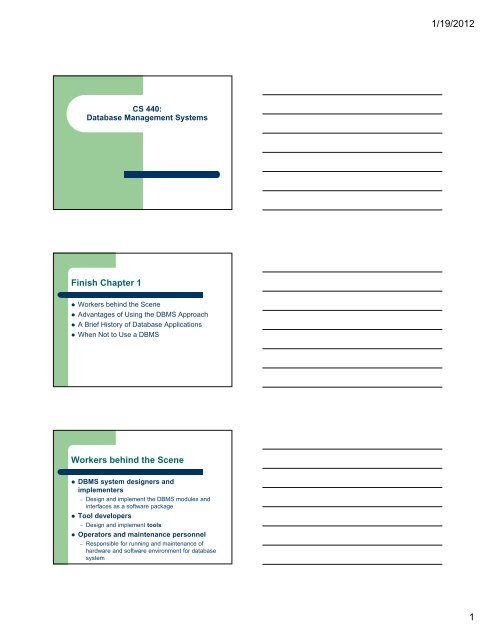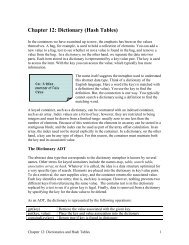Finish Chapter 1 Workers behind the Scene - Classes
Finish Chapter 1 Workers behind the Scene - Classes
Finish Chapter 1 Workers behind the Scene - Classes
You also want an ePaper? Increase the reach of your titles
YUMPU automatically turns print PDFs into web optimized ePapers that Google loves.
1/19/2012<br />
CS 440:<br />
Database Management Systems<br />
<strong>Finish</strong> <strong>Chapter</strong> 1<br />
• <strong>Workers</strong> <strong>behind</strong> <strong>the</strong> <strong>Scene</strong><br />
• Advantages of Using <strong>the</strong> DBMS Approach<br />
• A Brief History of Database Applications<br />
• When Not to Use a DBMS<br />
<strong>Workers</strong> <strong>behind</strong> <strong>the</strong> <strong>Scene</strong><br />
• DBMS system designers and<br />
implementers<br />
– Design and implement <strong>the</strong> DBMS modules and<br />
interfaces as a software package<br />
• Tool developers<br />
– Design and implement tools<br />
• Operators and maintenance personnel<br />
– Responsible for running and maintenance of<br />
hardware and software environment for database<br />
system<br />
1
1/19/2012<br />
Advantages of Using <strong>the</strong> DBMS<br />
Approach<br />
• Controlling redundancy<br />
– Data normalization<br />
– Denormalization<br />
• Sometimes necessary to use controlled redundancy to<br />
improve <strong>the</strong> performance of queries<br />
• Restricting unauthorized access<br />
– Security and authorization subsystem<br />
– Privileged software<br />
Advantages of Using <strong>the</strong> DBMS<br />
Approach (cont'd.)<br />
• Providing persistent storage for program<br />
objects<br />
– Complex object in C++ can be stored<br />
permanently in an object-oriented DBMS<br />
– Impedance mismatch problem<br />
• Object-oriented database systems typically offer data<br />
structure compatibility<br />
Advantages of Using <strong>the</strong> DBMS<br />
Approach (cont'd.)<br />
• Providing storage structures and search<br />
techniques for efficient query processing<br />
– Indexes<br />
– Buffering and caching<br />
– Query processing and optimization<br />
2
1/19/2012<br />
Advantages of Using <strong>the</strong> DBMS<br />
Approach (cont'd.)<br />
• Providing backup and recovery<br />
– Backup and recovery subsystem of <strong>the</strong> DBMS<br />
is responsible for recovery<br />
• Providing multiple user interfaces<br />
– Graphical user interfaces (GUIs)<br />
• Representing complex relationships among<br />
data<br />
– May include numerous varieties of data that are<br />
interrelated in many ways<br />
Advantages of Using <strong>the</strong> DBMS<br />
Approach (cont'd.)<br />
• Enforcing integrity constraints<br />
– Referential integrity constraint<br />
• Every section record must be related to a course record<br />
– Key or uniqueness constraint<br />
• Every course record must have a unique value for<br />
Course_number<br />
– Business rules<br />
– Inherent rules of <strong>the</strong> data model<br />
Advantages of Using <strong>the</strong> DBMS<br />
Approach (cont'd.)<br />
• Permitting inferencing and actions using<br />
rules<br />
– Deductive database systems<br />
• Provide capabilities for defining deduction rules<br />
• Inferencing new information from <strong>the</strong> stored database<br />
facts<br />
– Trigger<br />
• Rule activated by updates to <strong>the</strong> table<br />
– Stored procedures<br />
• More involved procedures to enforce rules<br />
3
1/19/2012<br />
Advantages of Using <strong>the</strong> DBMS<br />
Approach (cont'd.)<br />
• Additional implications of using <strong>the</strong> database<br />
approach<br />
– Reduced application development time<br />
– Flexibility<br />
– Availability of up-to-date information<br />
– Economies of scale<br />
A Brief History of Database<br />
Applications<br />
• Early database applications using<br />
hierarchical and network systems<br />
– Large numbers of records of similar structure<br />
• Providing data abstraction and application<br />
flexibility with relational databases<br />
– Separates physical storage of data from its<br />
conceptual representation<br />
– Provides a ma<strong>the</strong>matical foundation for data<br />
representation and querying<br />
A Brief History of Database<br />
Applications (cont'd.)<br />
• Object-oriented applications and <strong>the</strong> need for<br />
more complex databases<br />
– Used in specialized applications: engineering<br />
design, multimedia publishing, and manufacturing<br />
systems<br />
• Interchanging data on <strong>the</strong> Web for e-<br />
commerce using XML<br />
– Extended markup language (XML) primary<br />
standard for interchanging data among various<br />
types of databases and Web pages<br />
4
1/19/2012<br />
A Brief History of Database<br />
Applications (cont'd.)<br />
• Extending database capabilities for new<br />
applications<br />
– Extensions to better support specialized<br />
requirements for applications<br />
– Enterprise resource planning (ERP)<br />
– Customer relationship management (CRM)<br />
• Databases versus information retrieval<br />
– Information retrieval (IR)<br />
• Deals with books, manuscripts, and various forms of<br />
library-based articles<br />
When Not to Use a DBMS<br />
• More desirable to use regular files for:<br />
– Simple, well-defined database applications not<br />
expected to change at all<br />
– Stringent, real-time requirements that may not be<br />
met because of DBMS overhead<br />
– Embedded systems with limited storage capacity<br />
– No multiple-user access to data<br />
<strong>Chapter</strong> 2 Outline<br />
• Data Models, Schemas, and Instances<br />
• Three-Schema Architecture and Data<br />
Independence<br />
• Database Languages and Interfaces<br />
• The Database System Environment<br />
• Centralized and Client/Server Architectures<br />
for DBMSs<br />
• Classification of Database Management<br />
Systems<br />
5
1/19/2012<br />
Database System Concepts<br />
and Architecture<br />
• Basic client/server DBMS architecture<br />
– Client module<br />
– Server module<br />
Data Models, Schemas, and<br />
Instances<br />
• Data abstraction<br />
– Suppression of details of data organization and<br />
storage<br />
– Highlighting of <strong>the</strong> essential features for an<br />
improved understanding of data<br />
Data Models, Schemas, and<br />
Instances (cont'd.)<br />
• Data model<br />
– Collection of concepts that describe <strong>the</strong> structure<br />
of a database<br />
– Provides means to achieve data abstraction<br />
– Basic operations<br />
• Specify retrievals and updates on <strong>the</strong> database<br />
– Dynamic aspect or behavior of a database<br />
application<br />
• Allows <strong>the</strong> database designer to specify a set of valid<br />
operations allowed on database objects<br />
6
1/19/2012<br />
Categories of Data Models<br />
• High-level or conceptual data models<br />
– Close to <strong>the</strong> way many users perceive data<br />
• Low-level or physical data models<br />
– Describe <strong>the</strong> details of how data is stored on<br />
computer storage media<br />
• Representational data models<br />
– Easily understood by end users<br />
– Also similar to how data organized in computer<br />
storage<br />
Categories of Data Models<br />
(cont'd.)<br />
• Entity<br />
– Represents a real-world object or concept<br />
• Attribute<br />
– Represents some property of interest<br />
– Fur<strong>the</strong>r describes an entity<br />
• Relationship among two or more entities<br />
– Represents an association among <strong>the</strong> entities<br />
– Entity-Relationship model<br />
Categories of Data Models<br />
(cont'd.)<br />
• Relational data model<br />
– Used most frequently in traditional commercial<br />
DBMSs<br />
• Object data model<br />
– New family of higher-level implementation data<br />
models<br />
– Closer to conceptual data models<br />
7
1/19/2012<br />
Categories of Data Models<br />
(cont'd.)<br />
• Physical data models<br />
– Describe how data is stored as files in <strong>the</strong><br />
computer<br />
– Access path<br />
• Structure that makes <strong>the</strong> search for particular database<br />
records efficient<br />
– Index<br />
• Example of an access path<br />
• Allows direct access to data using an index term or a<br />
keyword<br />
Schemas, Instances, and Database<br />
State<br />
• Database schema<br />
– Description of a database<br />
• Schema diagram<br />
– Displays selected aspects of schema<br />
• Schema construct<br />
– Each object in <strong>the</strong> schema<br />
• Database state or snapshot<br />
– Data in database at a particular moment in time<br />
Three-Schema Architecture<br />
and Data Independence<br />
• Internal level<br />
– Describes physical storage structure of <strong>the</strong><br />
database<br />
• Conceptual level<br />
– Describes structure of <strong>the</strong> whole database for a<br />
community of users<br />
• External or view level<br />
– Describes part of <strong>the</strong> database that a particular<br />
user group is interested in<br />
8
1/19/2012<br />
Three-Schema Architecture<br />
and Data Independence (cont'd.)<br />
Conceptual level<br />
• Conceptual Schema (logical schema)<br />
– For our 440 class: Specify data types<br />
Students(sid: string, name: string, login: string,<br />
age: integer, gpa: real)<br />
Faculty(fid: string, fname: string, sal: real)<br />
Courses(cid: string, cname: string, credits: integer)<br />
Enrolled(sid: string, cid: string, grade: string)<br />
Teaches(fid: string, cid: string)<br />
Internal level<br />
• Physical Schema<br />
– Data Storage<br />
– Based on Access<br />
9
1/19/2012<br />
External or view level<br />
• External Schema<br />
– Different Views<br />
– Defined by end user requirements<br />
Courseinfo(cid: string, fname: string, enrollment: integer)<br />
Classification of Database<br />
Management Systems<br />
• Data model<br />
• Relational<br />
• Object<br />
• Hierarchical and network (legacy)<br />
• Native XML DBMS<br />
• Number of users<br />
• Single-user<br />
• Multiuser<br />
10
1/19/2012<br />
Classification of Database<br />
Management Systems (cont'd.)<br />
• Number of sites<br />
• Centralized vs. Distributed<br />
• Homogeneous vs. Heterogeneous<br />
• Cost<br />
• Open source<br />
• Different types of licensing<br />
• Types of access path options<br />
• General or special-purpose<br />
Classification of Database<br />
Management Systems (cont'd.)<br />
11

















